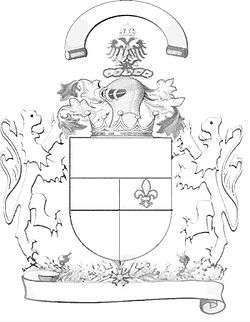Bend (heraldry)

| Part of a series on |
| Heraldic achievement |
|---|
| Conventional elements of coats of arms |
|
|
In heraldry, a bend is a band or strap running from the upper dexter (the bearer's right side and the viewer's left) corner of the shield to the lower sinister (the bearer's left side, and the viewer's right). Authorities differ as to how much of the field it should cover, ranging from one-fifth (if shown between other charges) up to one-third (if charged alone). The supposed rule that a bend should occupy a maximum of one-third of the field appears to exclude the possibility of two or three bends being shown together, but contrary examples exist. Outside of heraldry, the term "bend (or bar) sinister" is sometimes used to imply ancestral illegitimacy.
Modified bends
A bend can be modified by most of the lines of partition, such as the bend engrailed in the ancient arms of Fortescue or in the more modern examples of Cleethorpes Borough Council, England, and the bend wavy in the ancient coat of Wallop, Earls of Portsmouth of the modern Picard, Canada.
Bend sinister and "bar sinister"

| Look up bar sinister in Wiktionary, the free dictionary. |
The usual bend is occasionally called a bend dexter when it needs to contrast with the bend sinister, which runs in the other direction, like a sash worn diagonally from the left shoulder (Latin sinister means left).
The bend sinister and its diminutives such as the Baton sinister are rare as an independent motif; they occur more often as marks of distinction, added to another coat to denote bastardy. For example, Arthur Plantagenet, 1st Viscount Lisle (d.1542), illegitimate son of Edward IV of England, bore the arms of the House of York with a bendlet sinister overall.
It appears in more modern examples such as the arms of Lincolnshire County Council, England, and The Corporation of the Township of McNab/Braeside, Canada.
In French blazon a bend sinister is called a barre. Sir Walter Scott is credited with giving literature the macaronic phrase bar sinister, which has become a metonymic term for bastardy. In English blazon a bar is a horizontal stripe, symmetric with respect to sinister and dexter. (Bar and barre are pronounced alike.)
Diminutive forms
The diminutives of the bend, being narrower versions, are as follows, in descending order of width:
- Bendlet: One-half as wide as a bend, as in the coat of Vincent Leonard Knight, and in the coat of Manchester City Council, England. A bendlet couped is also known as a baton,[1] as in the coat of Elliot of Stobs (Public Register volume 1, page 144).
- Cotise: One-fourth the width of a bend; it appears only in pairs, one on either side (French: coté) of a bend, in which case the bend is said to be cotised as in the ancient arms of Fortescue and Bohun and in the more modern arms of John Stewart Archibald LeForte, and Hyndburn Borough Council, England.
- Riband or ribbon: Also one-fourth the width of a bend. It is also called a cost as in the coat of Abernethie of Auchincloich (Or, a lion rampant gules surmounted of a cost sable, all within a bordure engrailed azure — first and fourth quarters) (Public Register volume 1, page 69).
- Scarp (or Scarf): the diminutive of the bend sinister, as in the coat of Russ Wayne Copping.
Other
In bend

The phrase in bend refers to the appearance of several items on the shield being lined up in the direction of a bend, as in the arms of the ancient Northcote family of Devon: Argent, three crosses-crosslet in bend sable.[3] It is also used when something is slanted in the direction of a bend, as in the coat of Surrey County Council,[4] England.
Bendwise
A charge bendwise is slanted like a bend, as in the Canadian coat of Barry Lereng Wilmont. When a charge is placed on a bend, by default it is shown bendwise, as in the coat of Wilmslow Urban District Council, England.
Party per bend
A shield party per bend (or simply per bend) is divided into two parts by a single line which runs in the direction of a bend, as in the coat of Michael George Levy. Applies not only to the fields of shields but also to charges.
Bendy
.svg.png)
Bendy is a variation of the field consisting (usually) of an even number of parts,[1] most often six; as in the coat of the duchy of Burgundy.
Analogous terms are derived from the bend sinister: per bend sinister, bendwise sinister, bendy sinister.
Gallery
 Party per bend, argent and gules
Party per bend, argent and gules Argent a bend sinister gules
Argent a bend sinister gules Argent a bendlet gules
Argent a bendlet gules Argent a ribband gules
Argent a ribband gules Argent a baton gules
Argent a baton gules Bendy of six, gules and argent
Bendy of six, gules and argent
 Argent a bend cotised gules
Argent a bend cotised gules
In current sovereign flags
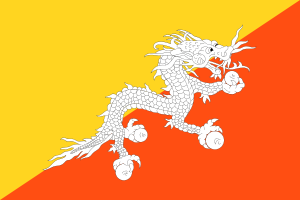
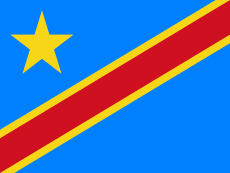 Flag of the Democratic Republic of the Congo: Azure, a bend sinister gules fimbriated or, in dexter chief a star of the last.
Flag of the Democratic Republic of the Congo: Azure, a bend sinister gules fimbriated or, in dexter chief a star of the last. Flag of the Republic of the Congo: Per bend sinister vert and gules, a bend sinister or.
Flag of the Republic of the Congo: Per bend sinister vert and gules, a bend sinister or.
 Flag of Papua New Guinea: Per bend gules and sable, in chief a bird of paradise or, and in base the stars of the Southern Cross argent.
Flag of Papua New Guinea: Per bend gules and sable, in chief a bird of paradise or, and in base the stars of the Southern Cross argent.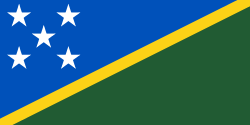 Flag of the Solomon Islands: Per bend sinister azure and vert, a riband sinister or, in dexter chief five stars in saltire argent.
Flag of the Solomon Islands: Per bend sinister azure and vert, a riband sinister or, in dexter chief five stars in saltire argent.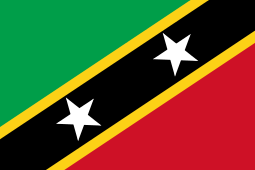 Flag of Saint Kitts and Nevis: Per bend sinister vert and gules, on a bend sable fimbriated or two stars argent.
Flag of Saint Kitts and Nevis: Per bend sinister vert and gules, on a bend sable fimbriated or two stars argent.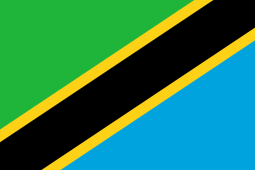
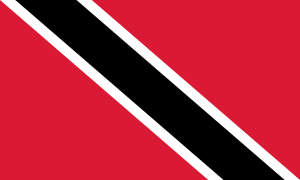 Flag of Trinidad and Tobago: Gules, a bend sable fimbriated argent.
Flag of Trinidad and Tobago: Gules, a bend sable fimbriated argent.
Notes and references
Further reading
- Boutell, Charles (1890). Heraldry, Ancient and Modern: Including Boutell's Heraldry. London: Frederick Warne. OCLC 6102523
- Brooke-Little, J P, Norroy and Ulster King of Arms, An heraldic alphabet (new and revisded edition), Robson Books, London, 1985 (first edition 1975); sadly very few illustrations
- Civic Heraldry of England and Wales, fully searchable with illustrations, http://www.civicheraldry.co.uk
- Clark, Hugh (1892). An Introduction to Heraldry, 18th ed. (Revised by J. R. Planché). London: George Bell & Sons. First published 1775. ISBN 1-4325-3999-X. LCCN 26-5078
- Canadian Heraldic Authority, Public Register, with many useful official versions of modern coats of arms, searchable online http://archive.gg.ca/heraldry/pub-reg/main.asp?lang=e
- Cussans, John E. (2003). Handbook of Heraldry. Kessinger Publishing. ISBN 0-7661-7338-0. LCCN 04-24470
- Fox-Davies, Arthur Charles (1909). A Complete Guide to Heraldry. New York: Dodge Pub. Co. ISBN 0-517-26643-1. LCCN 09-23803
- Friar, Stephen (ed) A New Dictionary of Heraldry Alphabooks, Sherborne, 1987
- Greaves, Kevin, A Canadian Heraldic Primer, Heraldry Society of Canada, Ottawa, 2000, lots but not enough illustrations
- Heraldry Society (England), members' arms, with illustrations of bearings, only accessible by armiger's name (though a Google site search would provide full searchability), http://www.theheraldrysociety.com/resources/members.htm
- Heraldry Society of Scotland, members' arms, fully searchable with illustrations of bearings, http://heraldry-scotland.com/copgal/thumbnails.php?album=7
- Innes of Learney, Sir Thomas, Lord Lyon King of Arms Scots Heraldry (second edition)Oliver and Boyd, Edinburgh, 1956
- Moncreiffe of Easter Moncreiffe, Iain, Kintyre Pursuivant of Arms, and Pottinger, Don, Herald Painter Extraordinary to the Court of the Lord Lyon King of Arms Simple Heraldry, Thomas Nelson and Sons, London andf Edinburgh, 1953; splendidly illustrated
- Neubecker, Ottfried (1976). Heraldry: Sources, Symbols and Meaning. Maidenhead, England: McGraw-Hill. ISBN 0-07-046312-3.
- Royal Heraldry Society of Canada, Members' Roll of Arms, with illustrations of bearings, only accessible by armiger's name (though a Google site search would provide full searchability), http://www.heraldry.ca/main.php?pg=l1
- South African Bureau of Heraldry, data on registered heraldic representations (part of National Archives of South Africa); searchable online (but sadly no illustration), http://www.national.archsrch.gov.za/sm300cv/smws/sm300dl
- Volborth, Carl-Alexander von (1981). Heraldry: Customs, Rules and Styles. Poole, England: Blandford Press. ISBN 0-7137-0940-5. LCCN 81-670212
- Woodcock, Thomas and John Martin Robinson (1988). The Oxford Guide to Heraldry. Oxford: University Press. ISBN 0-19-211658-4. LCCN 88-23554
- Woodward, John and George Burnett (1969). Woodward's a treatise on heraldry, British and foreign. Originally published 1892, Edinburgh: W. & A. B. Johnson. ISBN 0-7153-4464-1. LCCN 02-20303
External links
 Media related to Bends in heraldry at Wikimedia Commons
Media related to Bends in heraldry at Wikimedia Commons
